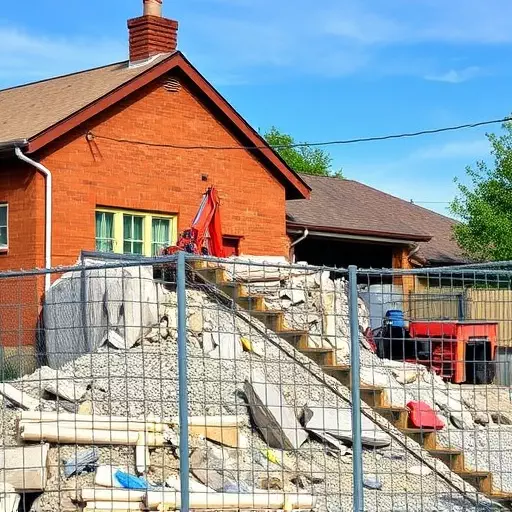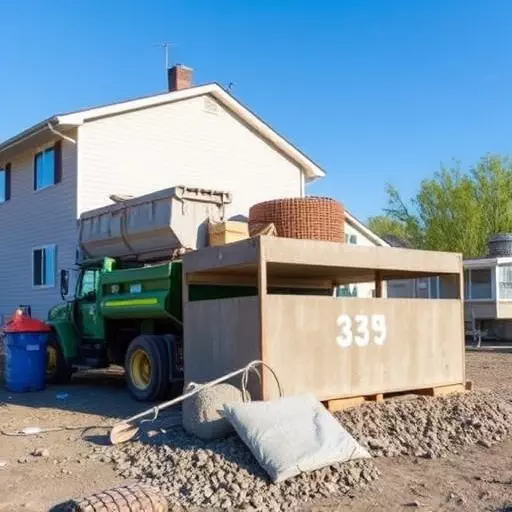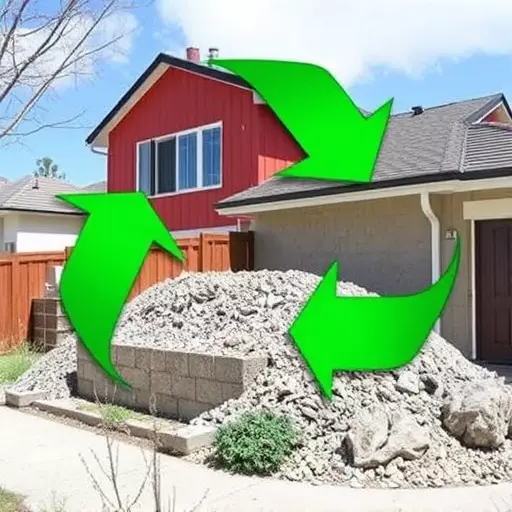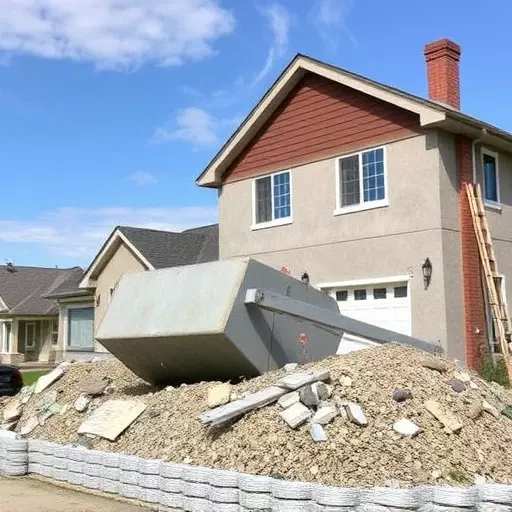Residential concrete recycling in Toledo is gaining popularity as a sustainable solution with significant environmental and economic advantages. The process starts with collecting concrete from demolitions and construction sites, crushing, screening, and washing it into recycled concrete aggregate (RCA). This RCA can be used in various applications like new concrete mixes, landscaping, or road construction, reducing the need for virgin resources and minimizing waste. By repurposing concrete, this practice conserves natural resources, reduces energy consumption, cuts carbon emissions, and diverts debris from landfills. Understanding how residential concrete recycling works is key to harnessing its benefits, fostering a more sustainable construction industry in Toledo.
“Discover the transformative power of residential concrete recycling in Toledo and its surrounding areas. This eco-friendly practice offers a sustainable solution for homeowners looking to reduce their environmental impact during renovations. From driveway removal to patio construction, learn how recycled concrete aggregates (RCA) can be utilized in various residential projects, offering both cost savings and environmental benefits.
Explore the multiple facets of this process, including its environmental advantages, operational mechanics, creative applications, and regulatory considerations. Understand the growing trends and best practices in residential concrete recycling, making informed choices for your construction needs while contributing to a greener community.”
- Understanding Residential Concrete Recycling in Toledo
- The Environmental Benefits of Residential Concrete Recycling
- Process and Operation: How Does Residential Concrete Recycling Work?
- Creative Uses for Recycled Concrete in Your Home
- Cost, Regulations, and Services: Navigating Residential Concrete Recycling
- Future and Best Practices in Residential Concrete Recycling
Understanding Residential Concrete Recycling in Toledo

In Toledo, understanding and adopting residential concrete recycling practices is a growing trend that offers numerous environmental and economic benefits. This process involves the collection, processing, and repurposing of concrete from various construction and demolition activities within residential areas. By embracing concrete recycling, Toledo residents and builders contribute to sustainable building practices and help reduce the city’s carbon footprint.
The process begins with the removal of used concrete from patios, driveways, foundations, and other residential structures. This material is then transported to specialized recycling facilities where it undergoes a series of steps, including crushing, screening, and washing, to produce recycled concrete aggregate (RCA). These recycled aggregates can be utilized in various ways, such as in new concrete mixtures for construction projects, landscaping, or as a base material for road construction, thereby reducing the demand for virgin resources and minimizing waste.
The Environmental Benefits of Residential Concrete Recycling

Residential concrete recycling offers significant environmental benefits by reducing the demand for new raw materials and minimizing waste. When concrete from construction sites, renovations, and demolitions is recycled, it helps to conserve natural resources like sand, gravel, and limestone, which are essential ingredients in traditional concrete production. This process also cuts down on energy consumption as manufacturing new concrete requires significant amounts of fuel. By repurposing existing concrete, carbon emissions and greenhouse gas releases are notably reduced, contributing to a more sustainable construction industry.
Moreover, residential concrete recycling plays a crucial role in mitigating landfilling practices. Landfills often overflow with concrete debris, which takes up valuable space and can leach harmful chemicals into the environment over time. Recycling allows this material to be reprocessed and given new life, diverting it from landfills and extending their lifespan. This not only preserves landfill space but also prevents potential environmental contamination associated with improper disposal of construction waste.
Process and Operation: How Does Residential Concrete Recycling Work?

Residential concrete recycling is a process that transforms concrete from old construction sites, renovations, and demolitions into reusable materials, offering numerous environmental benefits. It involves several steps to ensure the effective operation of this sustainable practice. First, the concrete debris is collected from residential projects, often including broken concrete, slabs, blocks, and even dust generated during cutting and drilling. This material is then transported to a recycling facility equipped with specialized machinery.
At the facility, the concrete is crushed into smaller pieces using crushers and screens to create recycled concrete aggregate (RCA). These machines allow for precise sizing and shape adjustments, ensuring the RCA meets specific requirements for various applications. The process may also include cleaning to remove any remaining contaminants, ensuring high-quality, durable, and environmentally friendly recycled product. This RCA can be utilized in a wide range of residential and construction projects, replacing virgin aggregate and reducing the demand for natural resources.
Creative Uses for Recycled Concrete in Your Home

Recycled concrete offers a wealth of creative possibilities for homeowners looking to reduce their environmental impact and save on construction costs. Beyond its traditional use in aggregate for new concrete mixes, recycled concrete can be transformed into unique and aesthetically pleasing home features. For instance, crushed or broken-up concrete can be used to create stunning garden paths, natural-looking landscaping beds, or even as a base for outdoor fire pits. These DIY applications not only give your outdoor spaces a distinctive look but also contribute to a circular economy by repurposing materials that would otherwise end up in landfills.
In the spirit of residential concrete recycling toledo, creative minds can incorporate recycled concrete into various home renovation projects. For example, it can be used as a cost-effective and eco-friendly alternative to traditional tiles or bricks for indoor flooring or wall accents. Additionally, recycled concrete blocks can be shaped and stacked to form eye-catching garden walls or retainers, while smaller pieces can be molded into unique planters or decorative sculptures. Embracing these innovative uses not only reduces waste but also allows homeowners to design homes that reflect their commitment to sustainability.
Cost, Regulations, and Services: Navigating Residential Concrete Recycling

Navigating Residential Concrete Recycling in Toledo
The cost of residential concrete recycling in Toledo can vary widely based on factors like the quantity of material, accessibility, and specific requirements. While it may seem more expensive upfront, many homeowners find that recycled concrete is a cost-effective option in the long run, offering significant savings compared to traditional landfill disposal methods. Moreover, with growing local regulations promoting sustainable construction practices, there are often incentives and tax benefits associated with recycling concrete in Toledo.
When considering residential concrete recyclers in Toledo, it’s crucial to understand and adhere to local guidelines and permits. This ensures a smooth process and minimizes potential penalties. Reputable recyclers will be well-versed in these regulations, providing transparent services that comply with environmental standards. They offer various options, including portable crushers for on-site recycling, convenient for projects like driveway removal or patio construction, as well as more traditional collection and transport services for larger jobs.
Future and Best Practices in Residential Concrete Recycling

The future of residential concrete recycling looks promising as technology advances and environmental awareness grows. Innovations in recycling equipment, such as more efficient crushers and screens, are reducing the energy and cost associated with processing concrete. These improvements make recycled concrete aggregate (RCA) a more viable and affordable option for construction projects, including new homes and renovations. As communities embrace sustainability, residential concrete recycling toledo is likely to become even more prevalent, contributing to a circular economy where waste is minimized and resources are conserved.
When it comes to best practices in residential concrete recycling, proper preparation of the material is key. This involves removing contaminants like wood, metal, and plastic from the concrete before crushing. Additionally, ensuring that concrete chunks are uniformly sized enhances the quality of RCA, making it suitable for various applications. Homeowners and contractors should also collaborate with reputable recyclers who follow strict environmental standards to guarantee that recycled materials meet required specifications and contribute positively to the environment, reinforcing the benefits of how residential concrete recycling works efficiently.


